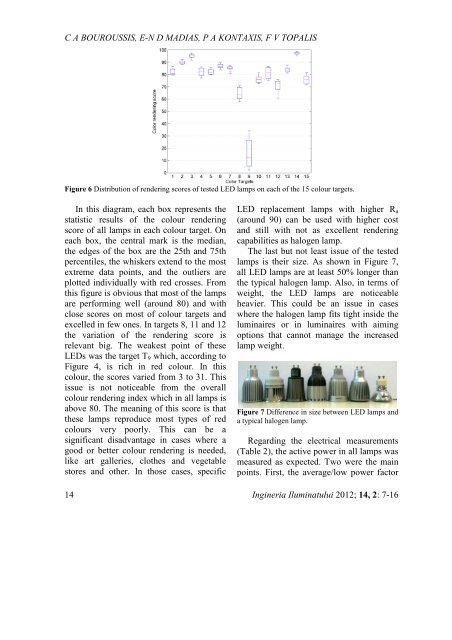Untitled - Journal of Lighting Engineering
Untitled - Journal of Lighting Engineering
Untitled - Journal of Lighting Engineering
Create successful ePaper yourself
Turn your PDF publications into a flip-book with our unique Google optimized e-Paper software.
C A BOUROUSSIS, E-N D MADIAS, P A KONTAXIS, F V TOPALIS<br />
Figure 6 Distribution <strong>of</strong> rendering scores <strong>of</strong> tested LED lamps on each <strong>of</strong> the 15 colour targets.<br />
In this diagram, each box represents the<br />
statistic results <strong>of</strong> the colour rendering<br />
score <strong>of</strong> all lamps in each colour target. On<br />
each box, the central mark is the median,<br />
the edges <strong>of</strong> the box are the 25th and 75th<br />
percentiles, the whiskers extend to the most<br />
extreme data points, and the outliers are<br />
plotted individually with red crosses. From<br />
this figure is obvious that most <strong>of</strong> the lamps<br />
are performing well (around 80) and with<br />
close scores on most <strong>of</strong> colour targets and<br />
excelled in few ones. In targets 8, 11 and 12<br />
the variation <strong>of</strong> the rendering score is<br />
relevant big. The weakest point <strong>of</strong> these<br />
LEDs was the target T9 which, according to<br />
Figure 4, is rich in red colour. In this<br />
colour, the scores varied from 3 to 31. This<br />
issue is not noticeable from the overall<br />
colour rendering index which in all lamps is<br />
above 80. The meaning <strong>of</strong> this score is that<br />
these lamps reproduce most types <strong>of</strong> red<br />
colours very poorly. This can be a<br />
significant disadvantage in cases where a<br />
good or better colour rendering is needed,<br />
like art galleries, clothes and vegetable<br />
stores and other. In those cases, specific<br />
14<br />
LED replacement lamps with higher Ra<br />
(around 90) can be used with higher cost<br />
and still with not as excellent rendering<br />
capabilities as halogen lamp.<br />
The last but not least issue <strong>of</strong> the tested<br />
lamps is their size. As shown in Figure 7,<br />
all LED lamps are at least 50% longer than<br />
the typical halogen lamp. Also, in terms <strong>of</strong><br />
weight, the LED lamps are noticeable<br />
heavier. This could be an issue in cases<br />
where the halogen lamp fits tight inside the<br />
luminaires or in luminaires with aiming<br />
options that cannot manage the increased<br />
lamp weight.<br />
Figure 7 Difference in size between LED lamps and<br />
a typical halogen lamp.<br />
Regarding the electrical measurements<br />
(Table 2), the active power in all lamps was<br />
measured as expected. Two were the main<br />
points. First, the average/low power factor<br />
Ingineria Iluminatului 2012; 14, 2: 7-16
















